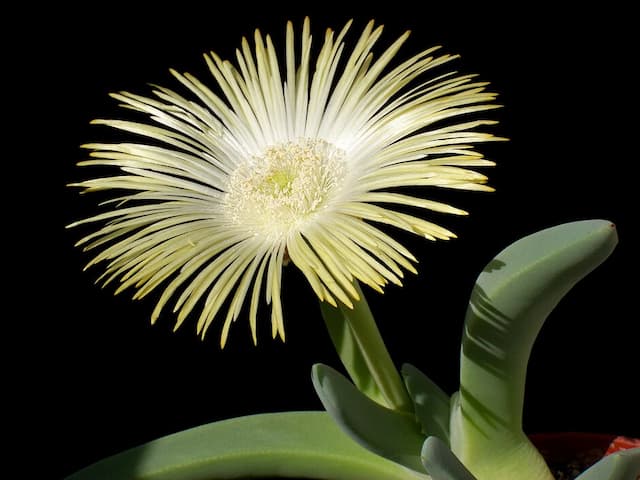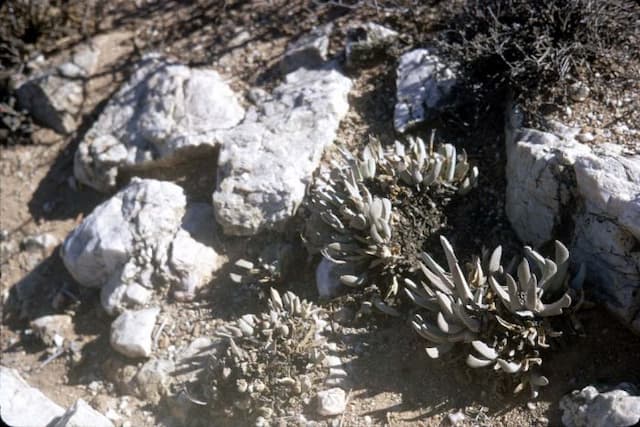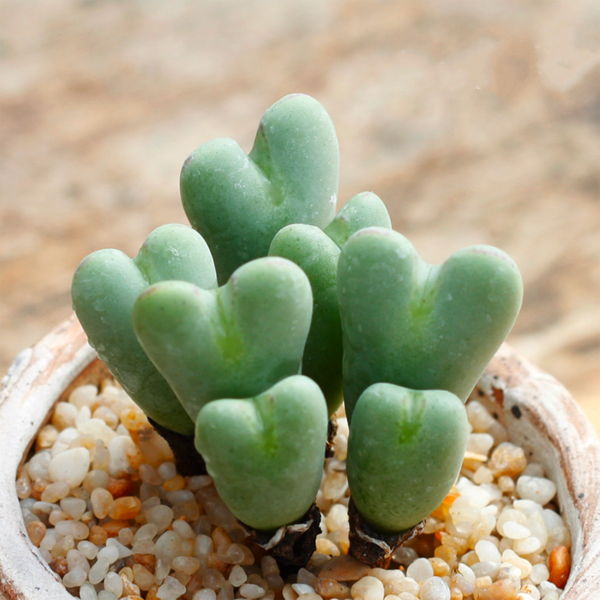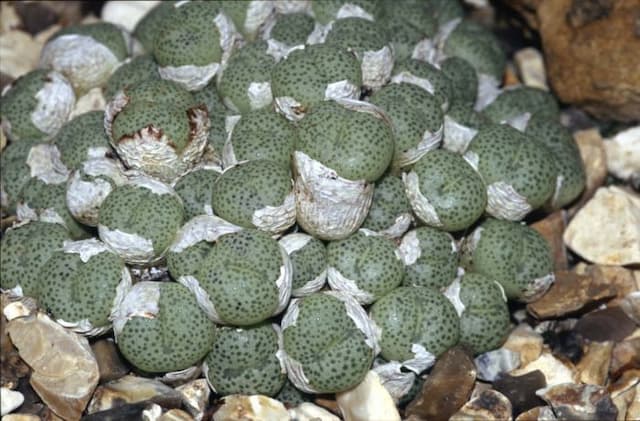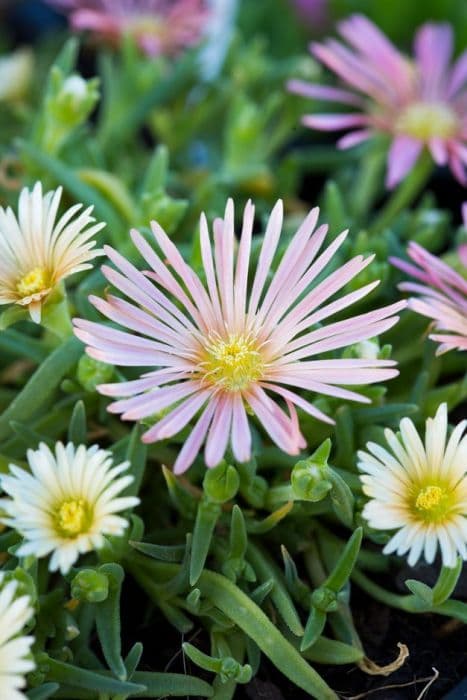Miniature Desert Rose Trichodiadema densum

ABOUT
Trichodiadema densum, commonly known as Miniature Desert Rose, is a succulent plant with a distinct appearance. The plant is characterized by its green, fleshy leaves, which are thick and rounded. These leaves are densely packed together in small clusters, giving the plant a bushy, lush look. Each leaf is covered in small, white, bristle-like structures that resemble diadems, contributing to an almost frosted appearance. The Miniature Desert Rose also boasts vibrant purple or pink flowers that emerge from the center of the leaf clusters. These flowers are daisy-like in shape, with a multitude of slender petals radiating from the center where a cluster of yellow stamens can typically be viewed. The contrast of the colorful blooms against the green foliage and white bristles makes this plant particularly eye-catching. The overall form of the Miniature Desert Rose is globular, with the dense leaf coverage often giving it a rounded, mound-like shape. This compact and textured look, topped with the striking flowers, makes the plant a unique and attractive addition to succulent collections and rock gardens alike.
About this plant
 Names
NamesFamily
Aizoaceae
Synonyms
Dense Bristle, Miniature Desert Rose
Common names
Mesembryanthemum densum.
 Toxicity
ToxicityTo humans
The plant Trichodiadema densum, commonly known as Miniature Desert Rose, is not widely reported to be toxic to humans. However, as a general precaution, it is advisable to avoid ingesting parts of ornamental plants as they might cause gastrointestinal discomfort or more serious health issues in certain individuals due to the presence of unknown or irritant compounds.
To pets
Trichodiadema densum, commonly called Miniature Desert Rose, does not typically appear on lists of plants known to be toxic to pets such as cats and dogs. Nonetheless, ingestion of non-food plants can sometimes result in mild stomach upset in pets, so it is wise to prevent your pets from consuming parts of this or any ornamental plant. If you suspect your pet has ingested part of the plant and is showing adverse symptoms, consult a veterinarian.
 Characteristics
CharacteristicsLife cycle
Perennials
Foliage type
Evergreen
Color of leaves
Green
Flower color
Purple
Height
6 inches (15 cm)
Spread
18 inches (45 cm)
Plant type
Succulent
Hardiness zones
10
Native area
South Africa
Benefits
 General Benefits
General Benefits- Drought Tolerance: Trichodiadema densum, commonly known as Miniature Pine Tree, is highly drought-resistant, making it suitable for xeriscaping and arid environments.
- Low Maintenance: This plant requires minimal care, which is ideal for gardeners seeking low-maintenance options.
- Groundcover: It spreads effectively, covering the ground and thus reducing weed growth and soil erosion.
- Ornamental Appeal: With its distinct pine-like appearance and vibrant flowers, it serves as an attractive addition to rock gardens and succulent collections.
- Suitable for Containers: Miniature Pine Tree thrives in pots, allowing for versatile placement and ease of moving according to seasonal needs.
- Attracts Pollinators: The flowers of Trichodiadema densum attract bees and other pollinators, supporting local ecosystems.
- Soil Improvement: This plant can help in improving soil structure as its roots can break up hard soils, making it beneficial for garden health.
- Adaptable: It can adapt to a wide range of soil types, although it prefers well-draining soils.
- Propagation Ease: Miniature Pine Tree is relatively easy to propagate from cuttings, making it simple for gardeners to expand their plantings.
- Compact Size: The small size of the plant makes it an excellent choice for ornamental use in limited spaces or as part of a succulent display.
 Medical Properties
Medical PropertiesThis plant is not used for medical purposes.
 Air-purifying Qualities
Air-purifying QualitiesThis plant is not specifically known for air purifying qualities.
 Other Uses
Other Uses- Miniature Gardening: Trichodiadema densum, commonly known as the Miniature Desert Rose, can be used in creating miniature gardens or fairy gardens due to its small size and desert-like appearance.
- Bonsai: The Miniature Desert Rose can be trained as a bonsai, offering an intriguing and succulent alternative to traditional bonsai plants.
- Photography Prop: Its unique structure and aesthetic make it a photogenic plant, suitable as a photography prop for close-up shots and artistic compositions.
- Educational Tool: The plant's ability to survive in arid conditions can be used to educate students and enthusiasts about drought-resistant plants and their adaptations.
- Container Displays: With its dense, mat-forming habit, the Miniature Desert Rose is ideal for adding texture and interest to container plant arrangements.
- Landscape Design: It can be used in rock gardens and xeriscaping projects to provide ground cover and reduce soil erosion, while requiring minimal maintenance and water.
- Artistic Inspiration: Artists and crafters may draw inspiration from the plant's unique form and incorporate its image into jewelry, paintings, and other works of art.
- Thematic Events: The Miniature Desert Rose can be featured in desert-themed events or settings, such as stage designs, to enhance the ambiance.
- Gift Plant: Its low-maintenance nature and distinctive look make it a suitable gift for plant enthusiasts who appreciate unusual succulents.
- Model Making: Hobbyists who create model landscapes, such as for model trains or dioramas, can use the Miniature Desert Rose as a realistic miniature shrub.
Interesting Facts
 Feng Shui
Feng ShuiThe Miniature desert rose is not used in Feng Shui practice.
 Zodiac Sign Compitability
Zodiac Sign CompitabilityThe Miniature desert rose is not used in astrology practice.
 Plant Symbolism
Plant SymbolismUnfortunately, there is no widely recognized symbolic meaning for the plant Trichodiadema densum, commonly known as Miniature Desert Rose. Due to its obscurity, it hasn't been allocated any specific symbolism in botanical literature or folklore. It is not a commonly exchanged plant with symbolism like the rose or lily. Therefore, an HTML list of symbolic meanings for Trichodiadema densum does not exist.
 Water
WaterThe Miniature Desert Rose should be watered using the "soak and dry" method, meaning water thoroughly when the soil is completely dry and then let it dry out completely before watering again. Generally, this may equate to once every 1-2 weeks, depending on the environmental conditions. When watering, slowly pour water around the base of the plant until excess water drains out of the bottom of the pot; this could mean using about 8-16 ounces of water for small to medium-size pots or more for larger containers. Adjust the amount and frequency as the seasons change, with less water needed during the dormant winter period.
 Light
LightThe Miniature Desert Rose thrives best in bright light with some direct sunlight. It should be placed in a location where it receives several hours of sunlight daily, preferably morning light which is less intense than afternoon sun. A south-facing or west-facing window would be ideal for providing the bright light conditions this plant prefers.
 Temperature
TemperatureThe Miniature Desert Rose can tolerate temperature ranges from 30°F to 100°F, but it thrives in temperatures between 65°F and 80°F. It’s important to protect the plant from frost and freezing temperatures, as they are not frost-tolerant.
 Pruning
PruningPruning the Miniature Desert Rose helps maintain its shape and encourage fuller growth. Prune in the early spring, before the new growth starts, by removing any dead or damaged branches as well as overly long stems to promote a more compact form. This plant does not require frequent pruning; an annual trim is typically sufficient unless shaping is desired throughout the year.
 Cleaning
CleaningAs needed
 Soil
SoilDense Redstem (Trichodiadema densum) prefers a well-draining cactus mix with added coarse sand or perlite. Aim for a soil pH between 6.0 and 7.5 for optimal growth conditions.
 Repotting
RepottingDense Redstem should be repotted every two to three years or when it has outgrown its current pot. Always use a container with ample drainage holes.
 Humidity & Misting
Humidity & MistingDense Redstem thrives in low to moderate humidity levels, typical of arid and semi-arid environments, and does not require high humidity.
 Suitable locations
Suitable locationsIndoor
Place Dense Redstem in bright, indirect light and ensure good airflow.
Outdoor
Plant in bright sunlight, protect from extreme cold.
Hardiness zone
9-11 USDA.
 Life cycle
Life cycleThe life cycle of Trichodiadema densum, also known as Miniature Desert Rose, begins with seed germination, which requires well-drained soil and warm temperatures typical of its native South African habitat. Once the seeds germinate, the seedlings develop fleshy leaves and a deep taproot that allows the plant to absorb and store water. As the plant matures, it enters a vegetative stage characterized by the growth of its distinctive succulent leaves and the development of a woody caudex. Trichodiadema densum will then begin its reproductive phase, producing bright pink to purple flowers that attract pollinators and lead to seed formation if pollination is successful. After pollination, seeds are dispersed, often by wind or water, completing the cycle. This plant is well-adapted to survive in arid conditions with periods of dormancy during extreme drought, resuming growth with the return of moisture.
 Propogation
PropogationPropogation time
Spring to Summer
The Small Red Carpet, or Trichodiadema densum, is commonly propagated by succulent enthusiasts using stem cuttings. This popular method involves taking a healthy stem cutting, typically a few inches in length (2-4 inches or 5-10 centimeters), allowing the cut end to callous over for a few days, and then planting it in well-draining soil. It is essential to provide bright, indirect light and to keep the soil lightly moist until the cutting has established roots, which usually takes several weeks. This simple method of propagation is favored due to its high success rate and the ease with which the cuttings can be handled and planted.
